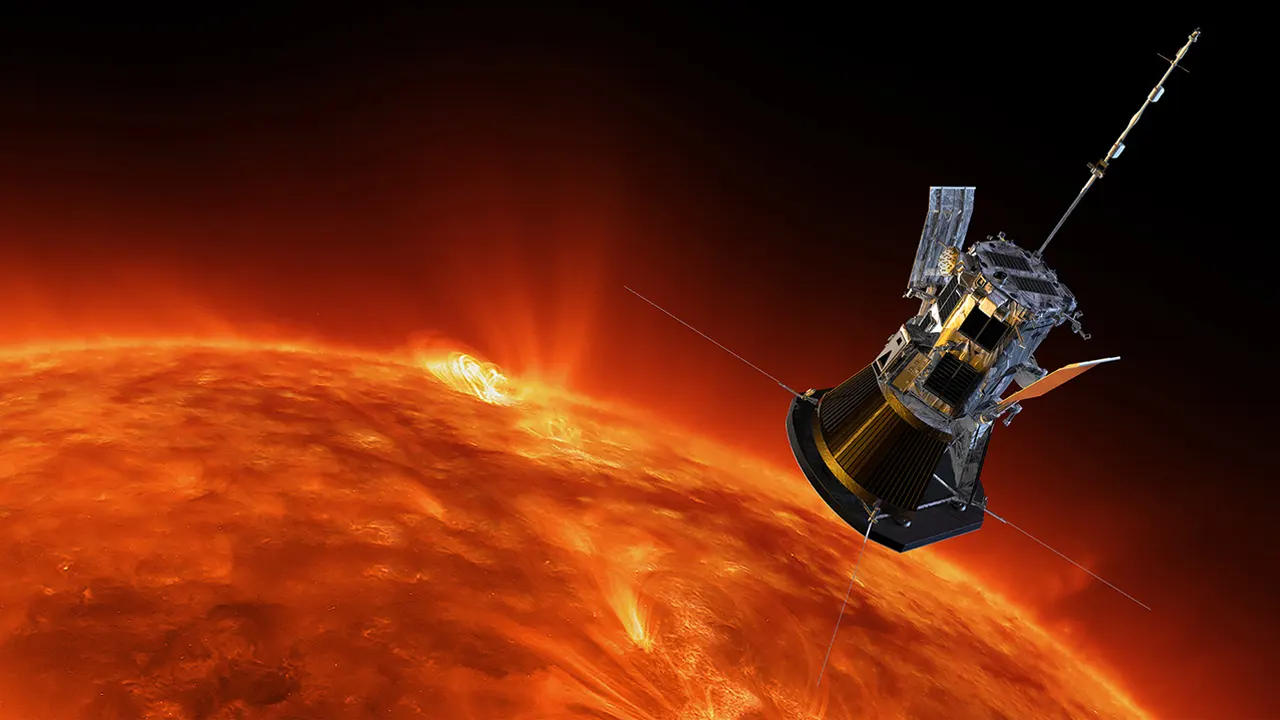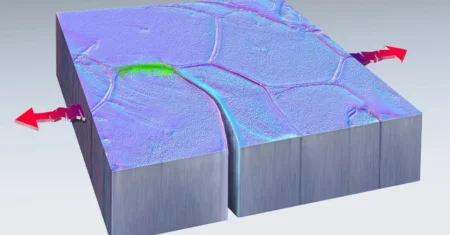Parker: The NASA Probe That Dared to “Touch” the Sun and Is Rewriting Our Understanding of the Star
 Foto: NASA
Foto: NASA
More than just spectacular images, the Parker Solar Probe is unraveling mysteries about the solar wind, the superheated corona, and the phenomena that directly affect Earth.
Imagine a spacecraft deliberately diving into the incandescent atmosphere of a star, facing temperatures capable of melting steel and overwhelming radiation. What sounds like science fiction is the reality of NASA’s Parker Solar Probe, one of the most audacious missions ever conceived by humanity. In December 2024, it broke all records by flying just 6.16 million kilometers from the Sun’s surface, becoming the fastest and closest object to the Sun ever built.
However, the Parker’s objective goes far beyond breaking records. It is the first mission to “touch the Sun,” flying through its outer atmosphere, the corona, to collect data directly from the source. In doing so, it seeks to answer fundamental questions about solar physics that have puzzled scientists for decades. Understanding our star is crucial, as solar phenomena, known as “space weather,” have the power to affect everything from our power grids and GPS satellites to the safety of future astronauts on missions to the Moon and Mars. This article is a complete guide to this modern odyssey: its innovative technology, its revolutionary discoveries, and what its legacy means for the future of science.
The Parker Mission: Objectives and Challenges of a Solar Odyssey
Launched in 2018, the Parker mission was designed to tackle two of the greatest mysteries in solar physics.
- The Coronal Heating Problem: A baffling paradox. The Sun’s visible surface, the photosphere, has a temperature of about 5,500°C. However, its outer atmosphere, the corona, reaches astounding temperatures of over a million degrees Celsius. How can the atmosphere be hundreds of times hotter than the heat source below it?
- The Acceleration of the Solar Wind: The Sun constantly emits a stream of charged particles, the solar wind, which travels throughout the solar system. Near the Sun, this wind is subsonic, but at some mysterious point, it is accelerated to supersonic speeds, exceeding 1.6 million kilometers per hour. What acts as this cosmic particle accelerator?
To survive this journey, the probe is a true marvel of engineering.
- The Revolutionary Thermal Protection System (TPS): The hero of the mission is a carbon-composite shield, 2.4 meters in diameter and only 11.43 cm thick. It protects the probe’s instruments, keeping them at a mild temperature of about 30°C, while the Sun-facing side endures temperatures of nearly 1,400°C.
- State-of-the-Art Scientific Instruments: Parker carries four instrument suites to “feel” and “taste” the solar environment: FIELDS measures electric and magnetic fields; SWEAP counts the solar wind particles (electrons, protons, and helium ions); IS☉IS (pronounced “Isis”) measures energetic particles; and WISPR is the sole imager, which photographs the corona and the solar wind. A crucial component of SWEAP is the “Faraday Cup,” a sensor that is directly exposed to the heat to collect solar wind particles.
- The Smart Orbit: The probe doesn’t fly directly into the Sun. Instead, it performs a complex orbital dance, using the gravity of the planet Venus in a series of seven flybys to slow down and adjust its trajectory, getting progressively closer to the Sun over a total of 24 planned orbits.
In the Heart of the Solar Fury: Parker’s Great Discoveries
Even before its most recent flyby, Parker had already transformed our understanding of the Sun.
- “Switchbacks”: The Magnetic Zig-zags of the Solar Wind: One of the first and most surprising discoveries was of S-shaped structures in the solar wind where the magnetic field suddenly reverses itself. The probe confirmed that these “switchbacks” are far more common than previously thought and likely originate from “magnetic funnels” in the photosphere. It is believed that the energy released in these structures is one of the keys to explaining both the heating of the corona and the acceleration of the solar wind.
- Touching the Sun: The Boundary of the Solar Corona: In 2021, Parker made history by crossing the so-called “Alfvén critical surface.” This is the point where the solar wind exceeds the speed of magnetic waves (Alfvén waves), marking the official boundary between the solar atmosphere and interplanetary space. By crossing this boundary, the probe confirmed that the corona is a much more dynamic and structured environment than seen from a distance, revealing a chaotic world of magnetic fields and particle flows.
- New Light on Space Weather: Parker has flown through several Coronal Mass Ejections (CMEs)—giant eruptions of plasma and magnetic fields from the Sun. Doing so allows scientists to study these dangerous solar storms in their earliest stages, providing crucial data to improve space weather prediction models.
The Record-Breaking Flight of December 2024 and What It Revealed
On December 24, 2024, the Parker Solar Probe performed its 22nd perihelion (closest point to the Sun), reaching impressive numbers.
- Minimum Distance: Just 6.16 million kilometers from the solar surface. For comparison, Mercury, the closest planet, orbits at an average distance of 58 million kilometers.
- Maximum Speed: Reached approximately 692,000 km/h (or 192 km/s). At this speed, it would be possible to travel from New York to Los Angeles in about 20 seconds.
The images and data collected during this flyby are invaluable. The WISPR imager captured unprecedented views of the so-called “coronal streamers,” bright structures of plasma that extend for millions of kilometers and are believed to be the source of the slow solar wind. By flying so close, Parker could observe the fine structures at the base of these streamers, the exact location where the solar wind begins its journey. Scientists are now analyzing particle and magnetic field data to correlate them with these images, searching for the “smoking gun” behind the wind’s acceleration.
The Legacy of Eugene Parker and the Future of Solar Exploration
The mission is named after astrophysicist Dr. Eugene Parker, who in 1958 theorized the existence of the solar wind, an idea initially met with skepticism. He lived to see his theory proven and, in an unprecedented feat, became the first living person to witness the launch of a spacecraft named in his honor, passing away in 2022.
The Parker mission does not work alone. It forms a powerful duo with the Solar Orbiter, a joint mission of the European Space Agency (ESA) and NASA. While Parker dives into the Sun, the Solar Orbiter observes it from a greater distance and a different orbit, capturing images of the Sun’s polar regions for the first time. Together, they provide an unprecedented 3D view of our star.
After completing its final orbits, the Parker Probe will run out of fuel to keep its shield pointed at the Sun. Eventually, it will destabilize and be consumed by the star it spent so long studying—a poetic end for a mission of sacrifice. The knowledge gained, however, will be its lasting legacy, essential for creating faster and more accurate solar storm warning systems, protecting our increasingly technological civilization.
A New Era in Solar Physics
The Parker Solar Probe is more than a robust machine; it is a testament to human curiosity and ingenuity. It has taken us closer to our star than we ever dreamed possible, and the data it sends back to Earth is, indeed, rewriting the textbooks on solar physics. By “touching” the Sun, Parker has not only solved old mysteries but has opened up a new universe of questions, ensuring that future generations of scientists will have much to explore. In its silent, solitary journey, it reminds us that to understand our place in the cosmos, we must first dare to approach the stellar forges that gave us life.
About the Author

0 Comments